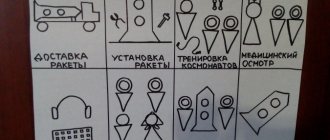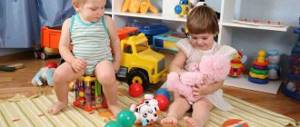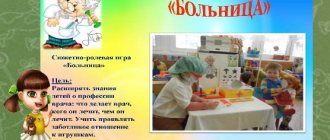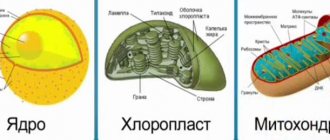The role and significance, the main tasks of the functioning of the book corner
According to the Federal State Educational Standard (FSES), the subject-spatial environment must be rich in content and include teaching aids, materials, equipment, tools, gaming, sports and recreational equipment. Regular classes in the corners of the group contribute to the formation and development of children’s skills in all types of educational activities: cognitive, artistic and aesthetic, gaming, motor, speech, labor.
The subject-spatial environment in preschool educational institutions contributes to the development of children’s skills and abilities
One of the mandatory areas for organizing a group room is a book corner.
In our world of rapidly developing technologies, the film industry and mass media, a child should not be confused and lose the opportunity to find a faithful and wise life partner - a book. It opens up a world of eternal values and teaches kindness in a way that is fun for children. By looking at book covers and illustrations, the child improves his visual perception skills. Children extract new information from stories and fairy tales - this is how cognitive and research abilities develop. Images of literary heroes and fragments of the listened plot appear in role-playing games and drawings by students - familiarization with the world of literature helps to reveal creative potential and activate the imagination. Based on favorite book stories, dramatization games are played and dialogues are learned by role - attention is paid to the child’s speech activity.
Communication with a book enriches children’s imagination and their play activities with new stories.
The purpose of organizing a book corner in kindergarten is to create favorable conditions for pupils to get acquainted with the world of fiction. It is recommended to involve parents in drawing up the material base of the corner, as well as holding consultations on encouraging children’s reading interests and the importance of discussing books read in the family circle.
Acquaintance with books in preschool age promotes the active development of imaginative thinking, perception of spoken words, and speech skills.
Objectives of the book corner
The objectives of the library corner, common to the entire learning process in a preschool educational institution, are:
1. Educational objectives
- creating positive motivation for learning to read;
- acquaintance with works of oral folk art and original works;
- acquaintance with the classics of children's literature;
- learning to search for knowledge in literary texts.
2. Developmental tasks
- formation and development of the skill of perceiving images from fiction and folklore;
- development of an emotional response to the content of books;
- developing the ability to correlate a graphic image with a listened text;
- formation of thinking abilities: comparison, analysis, highlighting the main thing, formulating conclusions;
- development of memory and fantasy;
- stimulation of speech activity, replenishment of vocabulary.
3. Educational tasks
- instilling a love of literature;
- nurturing a caring attitude towards books by studying the rules for using the book corner and carrying out work assignments;
- moral education through familiarity with stories about eternal human values: goodness, family, friendship, fidelity, etc.
In the book corner, children get acquainted with the world of literature
The teacher selects books and draws up a lesson plan in the book corner, taking into account the age characteristics of the children. Let us outline the main tasks of filling and operating the literary center for each kindergarten group.
1. First and second junior groups (1.5–3 and 3–4 years)
- acquaintance with the book, its structure and contents: cover, spine, pages, title, text, illustrations;
- examining book illustrations in order to recognize book characters and episodes;
- studying books about animals;
- development of fine motor skills when studying unusual books for the little ones: folding books, fabric books, books with windows, squeakers, laces, slots, finger toys, etc.;
- developing book handling skills.
Younger preschoolers are interested in fairy tales and poems about animals, they like to study toy books, baby books, etc.
2. Middle group (4–5 years old)
- learning how to repair a book;
- developing the ability to examine illustrations in detail and name the means of expression used by the artist;
- developing the ability to retell the plot through didactic games.
In the book corner for pupils aged 4–5 years there are sets of didactic games based on the works of
3. Senior and preparatory groups (5–6 and 6–7 years old)
- development of cognitive interests through the study of books about the surrounding world, animals and plants, space, dinosaurs, etc.;
- the formation of civic personality traits through the inclusion in the library corner of books about the significance of the homeland in a person’s life, about important events in the history of the country;
- familiarization with various types of printed materials: newspapers, magazines, brochures;
- viewing illustrated encyclopedias: children learn to understand not plot pictures, but graphic images of processes, systems, models;
- studying thematic exhibitions in the book corner dedicated to the work of a writer, holiday or memorable event.
The book corner for older preschoolers contains art books, encyclopedias, magazines, educational and board games
Requirements for a book corner in a preschool educational institution
Every preschool should have a book corner in every group. This requirement under the state program is mandatory for all kindergartens in the country. So that any preschooler can come up, look through a book, and comprehend what is within his or her age range. Such a place should be attractive, aesthetically designed so that children feel comfortable. Furniture is selected according to the height of the students. The younger the age group, the smaller the furniture should be.
In the older group
Bookcases and shelves in the senior group should be located in such a way that students can use the books displayed there. Sofas and chairs are selected according to the age of the children. And tables too. Everything should be convenient. Conducive to activities and studies. In the senior and preparatory groups, books should be selected in such a way that they already prepare children for future classes at school.
Children in the preparatory group are taught not only how to read, but also how to analyze the text they read. Retelling the text you read in your own words teaches you to speak correctly. This is also an important factor in the development of children.
Note! The corner with books should be located close to the window to provide comfortable lighting for reading.
A preschooler can sit down right there and read the words. There should be silence in such a place. Everything should contribute to the development of students.
When working with children in preparation for school, you should devote some of your books to the world around you. Find books about animals. Read to children in an accessible form those books that they themselves cannot yet read. Then you need to ask the students questions that they can answer.
In this way, together we can expand their knowledge about their native land, about nature, about animals. But the main thing is still fairy tales and children's stories; children should be taught to read them on their own. Independent reading develops not only the imagination, but also the mind. When a person reads, he pronounces the text. It turns out that the effect of what you read is double.
For the older group
In the middle group
A preschool reading corner in the middle group should be equipped according to the age of the readers. There you need to have illustrated books with fairy-tale characters. In the works of Marshak, Andersen, and other children's writers, children are looked at by cheerful, amusing characters. Even where there are slightly scary parts, for example, in the fairy tale about the wolf and the seven kids, the pictures should not frighten children. A book corner in the middle group equipped with such books greatly contributes to the development of children’s imagination.
How to teach a child to defend himself in kindergarten
Children at this age do not yet know how to read. But they willingly listen to what others read. The absorbed living images of the main characters of books form the inner world of a growing person. It is very important at this age to read those books that teach goodness and bring positivity. In order for children to grow up to be neat, well-mannered, decent people, it is necessary to lay down the first basic concepts of good and evil already in kindergarten.
Important. Reading books is in first place in terms of impact on the minds of the younger generation.
It is important to have humorous books with funny pictures. By looking at a funny picture and discussing it among themselves, children learn to understand and appreciate humor, to feel its depth and life-affirming value. By holding quizzes during the holidays and dressing up as fairy-tale characters during matinees, children become one team with their teachers. The events are accompanied by reading and learning poems. You need a complete set of necessary literature in the book corner.
For the middle group
In the preparatory group
Here children are just getting acquainted with the world of books and come into contact with literature. Works that touch the soul of every student must be on the shelves in such a small library. This includes Little Red Riding Hood, The Fox and the Bear, and many other fairy tales. When the teacher in the younger group expressively reads a fairy tale, there is silence. Children carefully follow the development of the plot. Over and over again, plunging their imagination into what is narrated in the fairy tale, students strengthen their inner world.
Here, books should be half with pictures, because children at a young age see and experience the world more vividly than later. They need a strong presentation. That's why they love to look at color images. It is necessary to select good books with bright pictures and read them at a certain time to the whole group. This will give positive and proper development to the children. Since at this age you need to develop your fingers, you need to not only keep children busy with drawing and modeling, but also entrust them with repairing books. This useful activity will give children an initial understanding of work and its value.
For the younger group
Work in the book corner of a kindergarten
The functioning of the book corner is aimed at introducing children to reading fiction. Preschoolers cannot read, but they love to listen and discuss. The book center hosts classes that combine various types of children's activities: studying visual material, conversation, didactic games, watching a presentation or video, listening to an audio fairy tale. The duration of the lesson depends on the age of the students: in the younger groups - 15 minutes, in the middle - 20, in the older - 25, in the preparatory - 30.
The lesson consists of listening to the text, discussing, looking at illustrations, games, etc.
About once a month it is recommended to hold themed leisure activities in the book corner. These are events dedicated to a topic or writer (“Poems about animals”, “Pushkin’s Fairy Tales”, “Winter Motifs”, “Poems about Mom”). Often, leisure time in a book corner synthesizes several educational areas (integrated events): literary and musical evenings, theatrical fairy tales, book-themed quests (“Let’s Help Pinocchio,” “Treasure Island”). Leisure combines an educational element with entertainment; in the junior and middle groups it lasts 25–30 minutes, in the senior and preparatory groups – 45–50.
Leisure time in the book corner can be devoted to poems about autumn by Russian poets, for example
Pupils aged 5–7 years are involved in project activities in the book corner. Children choose books on the topic and mark their favorite illustrations and episodes. The emotional response to works of fiction is embodied in the form of the final creative work - a poster, a panel made of plasticine or salt dough, drawings, homemade books.
The final stage of the project dedicated to the perception of the fairy tale by the Brothers Grimm is a performance
Main activities in the book corner
- Listening to literary works;
- cognitive and heuristic conversations;
- studying visual material: exhibitions, illustrations, portraits, covers;
- gaming activities: didactic games, dramatization games;
- work activity: all possible assistance in cleaning the book corner (wiping dust from bookshelves and printed publications), repairing books and magazines;
- independent study of printed publications.
Much attention is paid to independent activity, the teacher creates motivation to study books and develop interest.
Card index of tasks, exercises and games in the book corner
| Tasks |
|
| Game exercises |
|
| Movement exercises |
|
| Didactic games |
|
| Dramatization Games |
|
Why are book corners needed in kindergartens?
Even holding a book in their hands that smells of the alluring smell of printing ink, children come to some kind of amazing delight. And the pictures fascinate them even more. Books instill a love of reading in students, even when they cannot read. Seeing how the older ones read, either skilfully or fluently, the younger ones also follow them. They want to be the same smart and well-read children.
Book corner symbol
This is a very nice place - a book corner in a kindergarten. After all, kindergarten age is the most impressionable time of childhood. Therefore, all kindergarten groups have book corners.
Soon pupils in the younger groups learn that a lot of information about the world around them comes through books. No computer or gadget can replace a book. The content of colorfully designed paper collections of fairy tales is easily perceived by children. They worry about the heroes of fairy tales as if they were their friends. The world of children with books becomes richer, richer in volume and content.
Analysis of the design and operation of the book corner
The teacher analyzes the design and functioning of the book corner in order to identify points that require adjustment or improvement. The analysis is carried out according to the following criteria:
- Correct location of the corner: relative to other areas of children's activity, windows, doors.
- Convenience of furniture: cabinets and shelves for storing books, tables and desks, chairs and armchairs.
- Filling the corner: the correspondence of printed publications to the age of the pupils, a variety of books by topic and genre, the division of books by content, the presence of game material, albums for viewing.
- The aesthetics of the design: what decorates the corner, what exhibitions were held and whether they were interesting to children.
- Attendance by pupils: how often children study in the corner, in which shelves and objects the greatest interest was shown.
- Forms of work of the corner: what educational forms were carried out, in what activities the pupils were active, which caused increased emotional impact.
Analysis of the book corner in kindergarten
When analyzing, pay attention to the basic points in its design. The existing template prescribes the following conditions. Federal State Educational Standards standards require that any student, even the smallest in the group, can reach a book that interests him. The corner should be aesthetic and neat in appearance. It should be located where there is no playing area. Books must be age appropriate. They should be sorted by genre and content.
The corner should have some decorations. For example, paper signs, posters, graffiti. Have some bright attributes. Children should regularly visit the book corner, study here for a certain time with the teacher, but not only reading, but holding small festive events and theatrical children's performances here.
Book corner with theatrical elements
The book corner is an important part of the kindergarten. If it is properly designed, if the teacher carries out the necessary work with children in her group with love and diligence, then the students will grow up inquisitive and smart. Only for this you need to make efforts and skills, observing all the rules prescribed for preschool institutions.
Book corner as a topic for teacher self-education
Self-education of the teacher is carried out in two directions - theoretical and practical.
The theoretical part of self-education on the topic “Book Corner” begins with the study of methodological literature on the development of reading interest in preschoolers, familiarization with literary works that are traditionally included in the children's reading program and are new items in children's literature. The teacher compiles a list of books that are desirable for inclusion in the library corner of the kindergarten, works on drawing up a lesson plan and a list of thematic exhibitions during the school year.
An indispensable requirement for a teacher’s self-education is familiarization with the experience of colleagues: visiting and inspecting book corners in other groups and kindergartens. To help the teacher, there will be pedagogical Internet portals, where examples of designing book corners in accordance with the age characteristics of children are published, the introduction of ICT in the work of book centers, the use of innovative methods and pedagogical finds are described.
The teacher prepares a passport for the book corner, which indicates its location, equipment, content, and decoration elements. The passport specifies the goals of organizing a literary center in a group, tasks and forms of functioning, and describes exercises and games.
Practical activity consists of the joint activity of the teacher and children in the book corner and stimulating independent activities of pupils. Open classes and master classes are held for preschool teachers (including junior specialists) and parents. Ideas for decorating a book corner embodied in practice are recorded by the teacher in the form of articles for online and printed publications on preschool education; the inclusion of photographs and videos is encouraged.
The teacher shares his methodological experience of working in the book corner at pedagogical councils, conferences, open seminars and webinars. The corner may be nominated to participate in a pedagogical excellence competition.
As part of self-education, an analysis of the work done is carried out, gaps in the theoretical base, effective practical methods are indicated, ways of adjusting the functioning of the book corner, and the introduction of new forms of activity are identified.
Design of a book corner according to the Federal State Educational Standard
The established standard for the design of a book corner in a preschool institution must comply with the sanitary and hygienic standards of educational educational programs. Such standards are included in the legislative acts of federal laws relating to preschool institutions. Safety and convenience of learning with the help of book corners are the main ones when it comes to arranging such places in kindergarten groups.
English and learning the days of the week: exercise for children
Through reading, it is necessary to increase children's memory, teach them the rudiments of analytical thinking, and stimulate speech activity. The skill and perception of images is formed. The complexity of artistic thinking is easily perceived by students if the correct method of conveying artistic perception is chosen. Sound, letter, picture - everything becomes one row.
What name should I give?
Each book corner in a kindergarten should have its own name. This is usually done by book titles. The design of the reading corner in kindergarten should be reflected in the name. If the children in the group love a fairy-tale character most of all, then his name can be given to the book corner. Children will be delighted with this choice. For example, many children like the kitten Woof. Especially in younger groups.
After discussing this candidacy with the children and voting, you can choose the kitten Woof for the position of chief, responsible for order in the book corner. Pupils, taking part in the choice, will be filled with the importance of the assignment and will begin to take a responsible attitude towards their affairs.
Important. So, even through the name of the book corner, you can unobtrusively conduct educational work among children.
Book corner with title
First aid kit for books
Repairing or, in other words, treating books should be done not only by students in preparatory groups. It is necessary to involve other older groups in this matter. After all, repairing books, examining them, patching them, greatly disciplines children. They become imbued with the importance of the procedure being carried out.
Having gone through several such book repairs, the student will never drop these objects dear to his heart; he will always treat them with care. Because he already knows what it is to repair books. How difficult it is sometimes to glue badly torn pages back together. Therefore, the work plan in kindergartens includes activities for inspecting books, diagnosing them and treating them. And they treat books with glue, tape and other necessary tools. Sometimes it is possible to conduct joint examinations of books.
Note! The older one does important work, the younger one helps him.
A long-term plan for introducing children to literature in a book corner
It is recommended to draw up a long-term work plan in the book corner in the form of drawing up a weekly schedule of various forms of employment. For each planning item, a goal is determined that corresponds to the age and individual characteristics and interests of the students. The plan reveals the content of the literature, taking into account the frequency of updating for a specific age group of children, and indicates approximate directions for joint and independent activities of children.
Weekly planning template:
- Reading works of fiction: authors and titles of the work, purpose of familiarization;
- lesson: topic, purpose;
- exhibition: theme, purpose;
- individual work: content (memorization of poems, didactic games, exercises), purpose;
- collective work: content (art activities, theatrical games, project activities);
- leisure activities (held once a month): theme and content (holiday, creative evening, entertaining marathon, etc.), purpose.
The long-term plan may contain a separate item on working with parents as part of the functioning of the book corner: conducting consultations, joint leisure activities and projects.
The design of the corner as a mandatory element of the subject-spatial environment of the group is carried out within the framework of the educational order - the education of a comprehensively developed personality. Introducing to the world of literature and improving the ability to perceive images of literary texts lay the foundation for the growth of the child’s cultural growth. The little reader learns to treat the book as a source of knowledge and sensory experience of humanity, to see goodness and beauty in simple things and people's actions.







